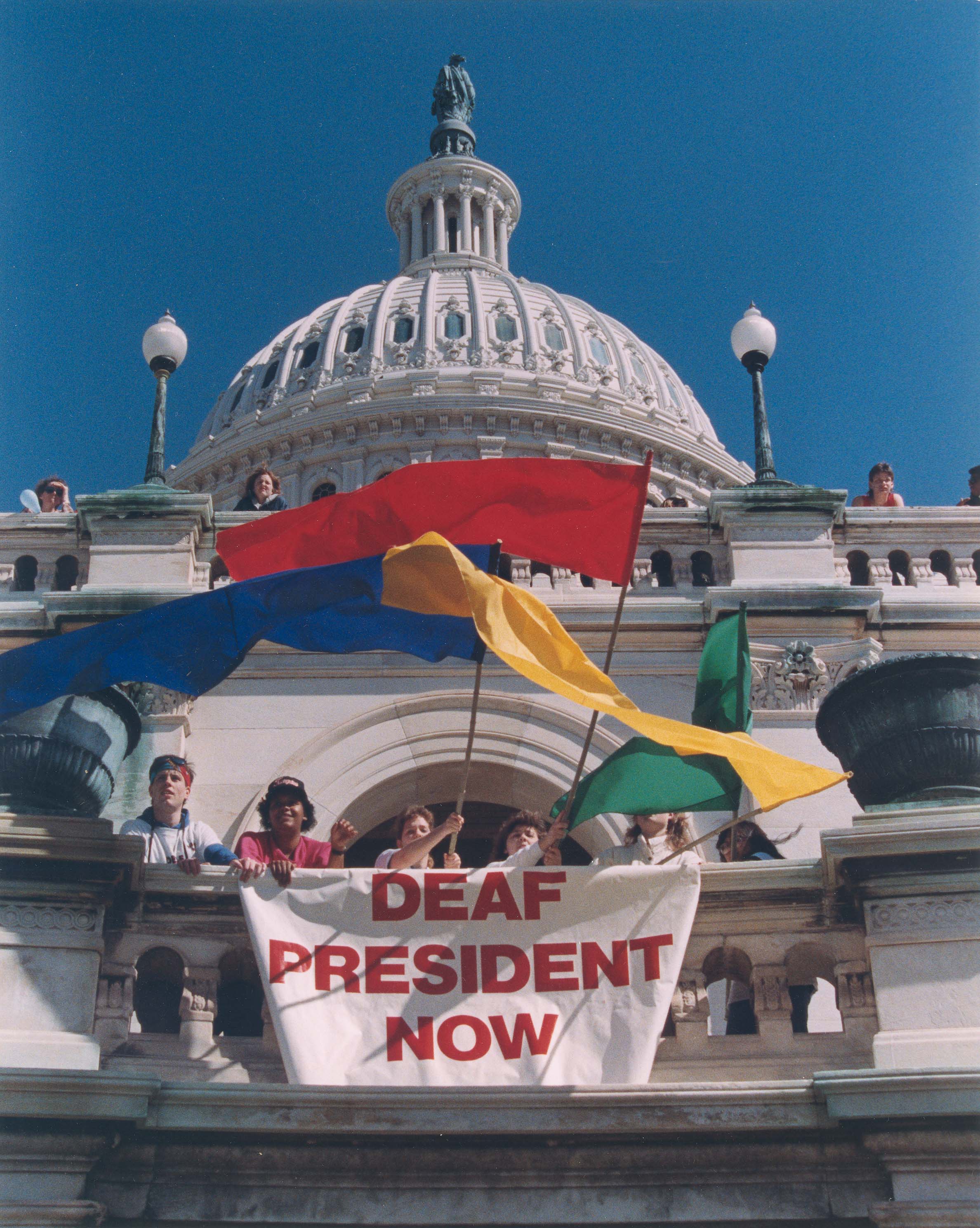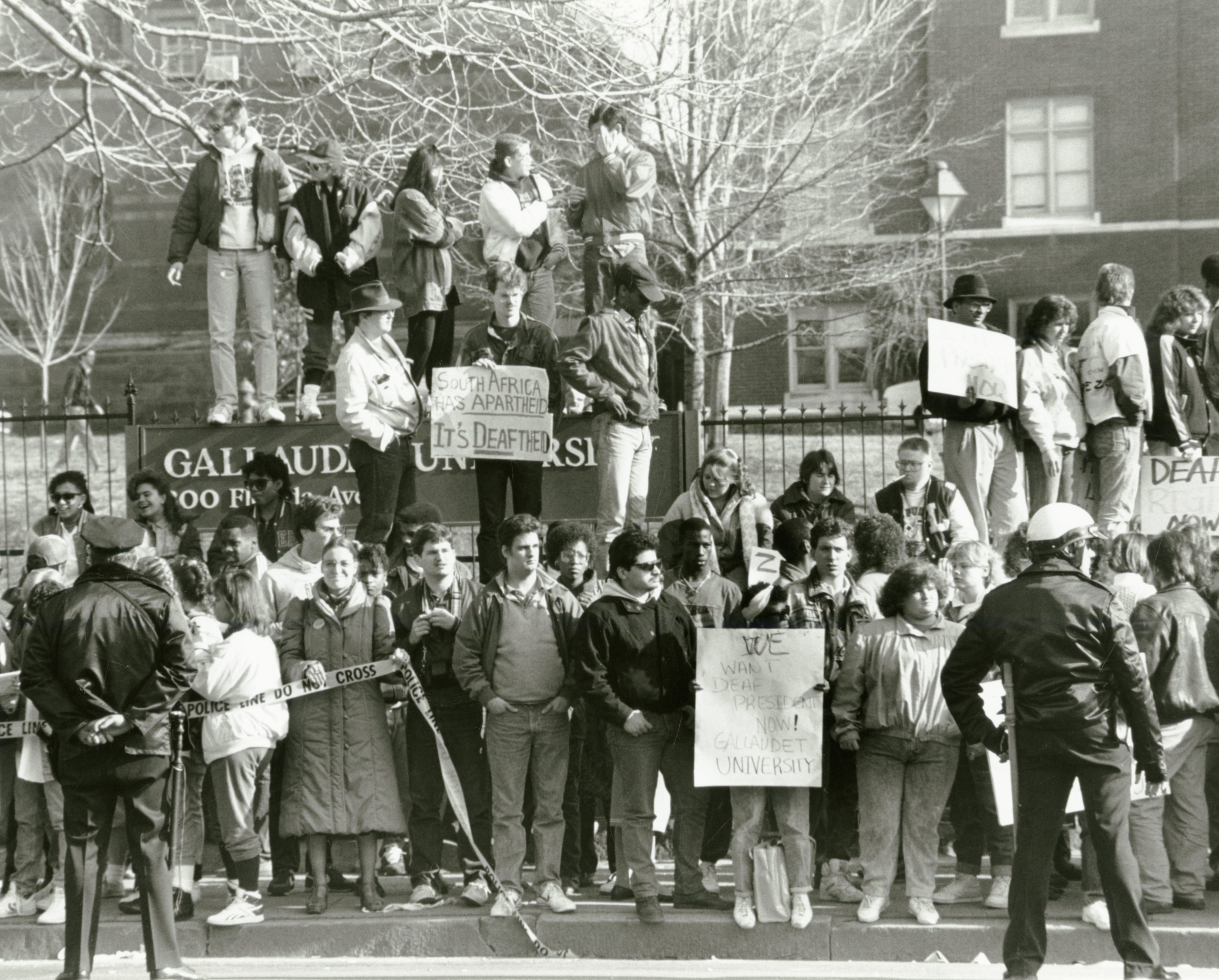It all started 30 years ago this March, when students at Gallaudet University, the only university in the world “designed to be barrier-free for deaf and hard-of-hearing students,” seized control of their campus. They took up a collection, bought locks, and chained the gates to the campus shut. They marched. They campaigned. They refused to relent until the Board of Trustees granted their core demand: appoint a Deaf president to lead Gallaudet. A week after the protests began, the board of trustees appointed Dr. I. King Jordan as president. Jordan quickly became a global leader for deaf and disability rights. The power demonstrated by the Gallaudet students fueled efforts around Deaf rights for years to come (including later protests at Gallaudet), but also helped catalyze efforts to pass the Americans With Disabilities Act.
The lessons from Deaf President Now should be clear. Its success, fueled by direct action, shows that rights have to be claimed rather than given. Deaf President Now stands as a watershed moment in the history not just of Deaf and disability rights, but also of American civil rights more broadly. As I spoke to people who had been instrumental in the protests, and the current president of Gallaudet, I heard one additional message: a fear that too few Americans even remember this story.

The story of Deaf President Now has been well documented. Gallaudet was founded in 1864, and for over a century its presidents were white and male and could hear. In 1988, the board of trustees, led by Chairperson Jane Spilman, selected three finalists. Two—I. King Jordan, Gallaudet’s current dean of arts and sciences, and Harvey Corson—were deaf. A third, Elisabeth Zinser, was not. Zinser had significant leadership experience in higher education, but no command of sign language or any real understanding of Deaf culture. When she was appointed on March 6th of that year, students marched to the Mayflower Hotel, where the board was holding a press conference, then to the United States Capitol to rally. Student leaders, with ample support from local citizens, chained the gates to the campus shut and issued demands: no reprisals, the resignation of Spilman, the resignation of Zinser, a new board of trustees with a majority Deaf population, and a new Deaf president.
It took a week of rallies, marches, speeches, media coverage, and advocacy behind closed doors, but eventually the board acceded to all these demands. I. King Jordan became the new president of Gallaudet and a leader in the broader disability rights movement, which also benefited from the example of the student leaders and the power of direct action.

How does direct action start? How do groups move from gathering angrily at a gym to locking the gates, organizing marches, seizing control of the story, and effecting change? As I spoke to various people who were involved in Deaf President Now and other people who care about Deaf and disability rights today (some of whom weren’t even born in 1988), I kept coming back to this question. Over the “Summer of ADAPT” last year, we saw disability activists seize control of the national narrative around health care through meticulously planned direct actions, including civil disobedience. More spontaneous actions, like DPN, also play a major role in the history of the Deaf and disability rights movements. As I spoke to Bridgetta Bourne-Firl, one of the four student leaders of Deaf President Now, and Fred Weiner, one of seven alumni who took the name “The Ducks” as they organized the broader community in support of DPN, I asked them about the night they marched to the Mayflower on March 6th, 1988. I wanted to know what drove the students of Gallaudet and their allies to seize control.
Over video chat and through an interpreter, Weiner tells me about “The Ducks,” a group of recent Gallaudet alumni who all lived in the D.C. area and regularly hung out together. Weiner wants me to understand that he and his friends had mostly watched their parents struggle to find white-collar work. He tells me that his father was the only Deaf child in his family and so became a printer, “whereas my father’s relatives became doctors and lawyers.” The Ducks were mostly in the same situation: recent graduates, just starting their careers, wondering how to overcome professional barriers. Another of the Ducks, for example, had a father who was a florist. “A lot of us saw our [Deaf] parents doing blue-collar work, knowing they could do more.” The campaign to seat the first Deaf president in university history became, for Weiner and others, not just about leadership at Gallaudet, but claiming a leadership position for all Deaf people.

(Photo: Courtesy of Gallaudet University Library Deaf Collections and Archives)
Both Weiner and Bourne-Firl recall the spark that ignited the protests. On the night of March 6th, the board was supposed to announce their choice for president at university’s gym. Instead, they just left out flyers reading “First female president,” to announce the choice of Zinser.
Bourne-Firl almost missed the protest. “I was a good student,” she tells me, “focused on my studies,” but she decided to leave off preparing for her mid-terms and go to the gym and hear the announcement. When she got there, she “found papers all over the ground. The board decided they wouldn’t make the announcement in person, but just left papers.”
Fred Weiner describes the scene from his perspective. “We just poured out into the street and did a sit-in. There must have been 1,000 people.” He remembers his boss, Gary Olson, the executive director of the National Association of the Deaf, saying: “Hey, it’s not that warm, while we’re standing out in the street really angry, the board is over at the Mayflower eating their steak and drinking their wine.” They marched.
Bourne-Firl, laughing, tells me that she was a cheerleader, so as they marched she came up with a chant, “Spilman out, Spilman out,” using sign language to make a play on the name of the board president. She shows me the sign for “spill” and then for “man,” helping me understand the ASL-only joke. Spilman quickly became one of the real villains of the movement; Bourne-Firl stops laughing as she tells me about the moment Zinser responded to protesters by explaining, “Deaf people are not ready to function in a hearing world.” Spilman would later contest that she’d ever made such a remark, blaming an interpretation error. Regardless, the reported remark thickened the resolve of the protesters. There was no turning back.

Roberta Cordano, the current president of Gallaudet, was just the 17th Deaf person in U.S. history to be accepted to law school. She went to the University of Wisconsin–Madison and was on spring break and back home in St. Paul, Minnesota, during Deaf President Now. Cordano distinctly remembers news of the protest spreading through teletype writers initially, but soon it became front-page news in Washington and beyond. Cordano tells me over video chat that Deaf President Now modeled the “best of the Deaf community, a passion for change—it came from the students, who challenged the status quo.” But the students weren’t alone, she says: “Behind the young folks were a group of alumni who were advisers and friends, continually counseling the young folks on systems that they needed to change. It was beautiful.”

Anniversaries prompt forecasting as well as retrospection. As I talked to Bourne-Firl, Weiner, and Cordano about the long-term meaning of Deaf President Now, they all started discussing the challenges to of ensuring access to Deaf culture for children today. “Deaf President Now was about showing the world that we can. Since [then], we’ve lived with the determination that we will.” She still sees too much “binary thinking,” the idea that children must be raised with either a visual or spoken language, rather than trying to understand how sign-language and spoken language work together.
Bourne-Firl, who works today on Deaf education at Gallaudet, talks to me about hearing tests that children receive as infants and that they “pass” or “fail.” Being Deaf is not a failure, but “a difference,” and she wants to change that whole conversation. One piece of that change requires making Deaf history, especially moments like Deaf President Now that demonstrate the vibrant culture of the Deaf community, more visible. Bourne-Firl tells me: “Deaf President Now is an American story. It’s not my story, or only the Deaf community’s story, or Gallaudet’s story, but an American Civil Rights story. It needs to be told in every school.”
As for Weiner, he tells me a story about the time his eight-year-old daughter saw a statue of Edward Gallaudet, who founded and became the first president of Gallaudet in 1864. He was not Deaf, a possibility that never occurred to Weiner’s daughter, who looked at the statue and said, “He’s Deaf of course.” Weiner pauses, then tells me, “There’s a generation of children thinking Deaf people can really do anything.”





